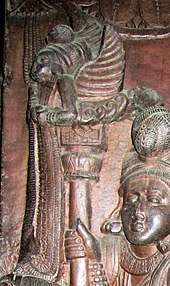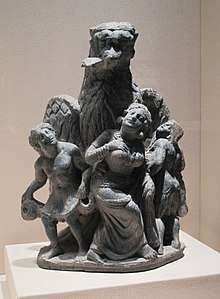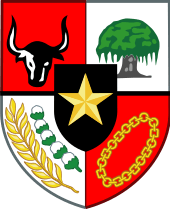Garuda
Garuda (Sanskrit: गरुड़ Garuḍa; Pāli: गरुळ Garuḷa) is a legendary bird or bird-like creature in Hindu, Buddhist and Jain mythology.[1][2][3] He is variously the vehicle mount (vahana) of the Hindu god Vishnu, a dharma-protector and Astasena in Buddhism, and the Yaksha of the Jain Tirthankara Shantinatha.[2][3][4]
| Garuda | |
|---|---|
The mount of Lord Vishnu | |
 Garuda at the National Museum in New Delhi, India. | |
| Devanagari | गरुड़ |
| Sanskrit transliteration | Garuḍa |
| Affiliation |
|
| Personal information | |
| Parents | Kashyapa and Vinata |
| Siblings | Aruṇa |
Garuda is described as the king of birds and a kite-like figure.[5][6] He is shown either in zoomorphic form (giant bird with partially open wings) or an anthropomorphic form (man with wings and some bird features). Garuda is generally a protector with power to swiftly go anywhere, ever watchful and an enemy of the serpent.[1][6][7] He is also known as Tarkshya and Vynateya.[8]
Garuda is a part of state insignia in India, Myanmar, Thailand, Cambodia and Indonesia. The Indonesian official coat of arms is centered on the Garuda. The national emblem of Indonesia is called Garuda Pancasila. The Indian Air Force also uses the Garuda in their coat of arms and named their special operations unit after it as Garud Commando Force.[9] It is often associated with the greater adjutant (Leptoptilos dubius) stork.[10][11]
Hinduism
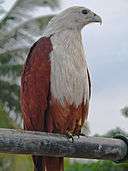
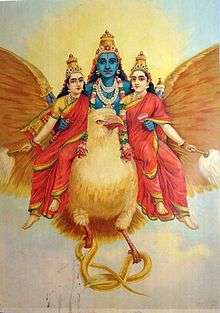
In Hinduism, Garuda is a divine eagle-like sun bird and the king of birds.[5] A Garutman is mentioned in the Rigveda who is described as celestial deva with wings.[12][13] The Shatapatha Brahmana embedded inside the Yajurveda text mentions Garuda as the personification of courage. In the Mahabharata, Garutman is stated to be same as Garuda, then described as the one who is fast, who can shapeshift into any form and enter anywhere.[12] He is a powerful creature in the epics, whose wing flapping can stop the spinning of heaven, earth and hell. He is described to be the vehicle mount of the Hindu god Vishnu, and typically they are shown together.[12]
According to George Williams, Garuda has roots in the verb gri, or speak.[13] He is a metaphor in the Vedic literature for Rik (rhythms), Saman (sounds), Yajna (sacrifices), and the atman (Self, deepest level of consciousness). In the Puranas, states Williams, Garuda becomes a literal embodiment of the idea, and the Self who attached to and inseparable from the Supreme Self (Vishnu).[13][14] Though Garuda is an essential part of the Vaishnavism mythology, he also features prominently in Shaivism mythology, Shaiva texts such as the Garuda Tantra and Kirana Tantra, and Shiva temples as a bird and as a metaphor of atman.[14][15][16]
Iconography
The Hindu texts on Garuda iconography vary in their details. If in the bird form, he is eagle-like, typically with the wings slightly open as if ready and willing to fly wherever he needs to.[6] In part human-form, he may have an eagle-like nose, beak or legs, his eyes are open and big, his body is the color of emerald, his wings are golden-yellow. He may be shown with either two or four hands.[6] If he is not carrying Vishnu, he holds a jar of amrita (immortality nectar) in one hand in the rear and an umbrella in the other, while the front pair of hands are in anjali (namaste) posture. If he is carrying Vishnu, the rear hands provide the support for Vishnu's feet.[6][7]
According to the text Silparatna, states Rao, Garuda is best depicted with only two hands and with four bands of colours: "golden yellow colour from feet to knees, white from knees to the navel, scarlet from navel to neck, and black above the neck". His hands, recommends the text, should be in abhaya (nothing to fear) posture.[6] In Sritatvanidhi text, the recommended iconography for Garuda is a kneeling figure, who wears one or more serpents, pointed bird-beak like nose, his two hands in namaste posture. This style is commonly found in Hindu temples dedicated to Vishnu.[6]
In some iconography, Garuda carries Lord Vishnu and his two consorts by his side: Lakshmi(Thirumagal) and Bhūmi (Bhuma-Devi).[8][18]
Garuda iconography is found in early temples of India, such as on the underside of the eave at Cave 3 entrance of the Badami cave temples (6th-century).[6][19]
Mythology
_in_the_background.jpg)
Garuda's mythology is linked to that of Aruna – the charioteer of Surya (The Hindu Sun god). However, these Indian mythologies are inconsistent across texts. Both Aruna and Garuda developed from an egg. According to one version related by George Williams, Kashyapa Prajapati's two wives Vinata and Kadru wanted to have children, and Kashyapa granted each of them a boon.[20] Kadru asked for one thousand Nāga sons, while Vinata asked for just two, but each an equal to all of Kadru's thousand sons. Kashyapa blessed them, and then retreated to a forest to meditate. Later, Kadru gave birth to one thousand eggs, while Vinata gave birth to two eggs. After incubating them for five hundred years, Kadru's eggs hatched and out came her 1,000 sons. Vinata, eager for her own sons, impatiently broke one of her eggs. From this egg emerged the partially formed Aruna, looking radiant and reddish as the morning sun - but not as bright as the midday sun as he was promised to be.[20][21] Aruna chided his mother, Vinata for her impatience, and warned her to not break open the second egg, cursing her to be a slave until his brother rescued her. Aruna then left to become the charioteer of Surya, the sun god.
Vinata waited, and after many years the second egg hatched, and Garuda was born. After losing a bet to Kadru through trickery, Vinata was forced to become her slave. Garuda later on asked his brothers to free his mother from her slavery, to which they demanded Amrita from heaven. Garuda waged a war against gods with his extraordinary might and abilities beyond thinking, and defeated all of them, including Indra. He then took Indra's nectar vessel and flew back to earth. Vishnu then came to Garuda, and asked him to be his ride, to which he agreed. Indra request that Garuda not give the Amrita to the Nagas though, as it would bring great trouble later, so they forged a plan. Upon reaching his brothers Garuda placed the vessel before them, and asked them to first purify themselves before drinking. Meanwhile, Jayanta (the son of Indra) stole the vessel back. On returning, the nagas were all devoured by Garuda.[20][22]
Some myths present Garuda as so massive that he can block out the sun.[23] The text Garuda Purana is named after him.[24]
Garuda is presented in the Mahabharata mythology as one who eats snake meat, such as the story about him planning to kill and eat Sumukha snake, where Indra intervenes. Garuda in anger, vaunt about his feats and compares himself to Indra's equal. Vishnu teaches lesson to Garuda and cured his pride on might.[25] Garudas are also a race of birds who devour snakes in the epic.[25]
The Suparṇākhyāna, a late Vedic period poem considered to be among the "earliest traces of epic poetry in India," relates the legend of Garuda, and provides the basis for a later, expanded version which appears within the Mahābhārata.[26][27]
Symbolism
Garuda's links to Vishnu – the Hindu god who fights injustice and destroys evil in his various avatars to preserve dharma, has made him an iconic symbol of king's duty and power, an insignia of royalty or dharma. His eagle-like form is shown either alone or with Vishnu, signifying divine approval of the power of the state.[13] He is found on the faces of many early Hindu kingdom coins with this symbolism, either as a single-headed bird or a three-headed bird that watches all sides.[28]
Throughout the Mahabharata, Garuda is invoked as a symbol of impetuous violent force, of speed, and of martial prowess. Powerful warriors advancing rapidly on doomed foes are likened to Garuda swooping down on a serpent. Defeated warriors are like snakes beaten down by Garuda. The Mahabharata character Drona uses a military formation named after Garuda. Krishna even carries the image of Garuda on his banner.
Buddhism
Garuda, also referred to as Garula, are golden-winged birds in Buddhist texts. Under the Buddhist concept of saṃsāra, they are one of the Aṣṭagatyaḥ, the eight classes of inhuman beings. In Buddhist art, they are shown as sitting and listening to the sermons of the Buddha.[1] They are enemies of the Nāgas (snakes) and are sometimes depicted with a serpent held between their claws. Like the Hindu art, both zoomorphic (giant eagle-like bird) and partially anthropomorphic (part bird, part human) iconography is common across Buddhist traditions.[1]
.jpg)
In Buddhism, the Garuda (Sanskrit; Pāli: garuḷā) are enormous predatory birds with a wingspan of 330 yojanas.[1] They are described as beings with intelligence and social organization. They are also sometimes known as suparṇa (Sanskrit; Pāli: supaṇṇa), meaning "well-winged, having good wings". Like the Nāgas, they combine the characteristics of animals and divine beings, and may be considered to be among the lowest of the devas.[1] The Garudas have kings and cities, and at least some of them have the magical power of changing into human form when they wish to have dealings with people. On some occasions Garuda kings have had romances with human women in this form. Their dwellings are in groves of the simbalī, or silk-cotton tree.
Jataka stories describe them to be residents of Nagadipa or Seruma.[1]
The Garuda are enemies to the nāga, a race of intelligent serpent- or dragon-like beings, whom they hunt. The Garudas at one time caught the nāgas by seizing them by their heads; but the nāgas learned that by swallowing large stones, they could make themselves too heavy to be carried by the Garudas, wearing them out and killing them from exhaustion. This secret was divulged to one of the Garudas by the ascetic Karambiya, who taught him how to seize a nāga by the tail and force him to vomit up his stone (Pandara Jātaka, J.518).
The Garudas were among the beings appointed by Śakra to guard Mount Sumeru and the Trāyastriṃśa heaven from the attacks of the asuras.
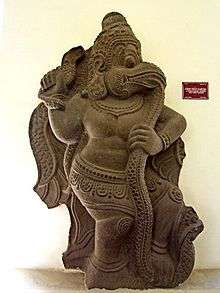
In the Maha-samaya Sutta (Digha Nikaya 20), the Buddha is shown making temporary peace between the Nagas and the Garudas.
In the Qing Dynasty fiction The Story of Yue Fei (1684), Garuda sits at the head of the Buddha's throne. But when a celestial bat (an embodiment of the Aquarius constellation) flatulates during the Buddha's expounding of the Lotus Sutra, Garuda kills her and is exiled from paradise. He is later reborn as Song Dynasty General Yue Fei. The bat is reborn as Lady Wang, wife of the traitor Prime Minister Qin Hui, and is instrumental in formulating the "Eastern Window" plot that leads to Yue's eventual political execution.[29] The Story of Yue Fei plays on the legendary animosity between Garuda and the Nagas when the celestial bird-born Yue Fei defeats a magic serpent who transforms into the unearthly spear he uses throughout his military career.[30] Literary critic C. T. Hsia explains the reason why Qian Cai, the book's author, linked Yue with Garuda is because of the homology in their Chinese names. Yue Fei's courtesy name is Pengju (鵬舉).[31] A Peng (鵬) is a giant mythological bird likened to the Middle Eastern Roc.[32] Garuda's Chinese name is Great Peng, the Golden-Winged Illumination King (大鵬金翅明王).[31]
Jainism
The Garuda is a yaksha or guardian for Shantinatha in Jain iconography and mythology.[2][3] Jain iconography shows Garuda as a human figure with wings and a strand-circle.[33]
As a cultural and national symbol
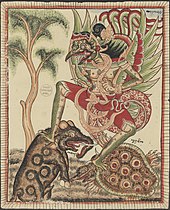
In India, Indonesia and the rest of Southeast Asia the eagle symbolism is represented by Garuda, a large bird with eagle-like features that appears in both Hindu and Buddhist epic as the vahana (vehicle) of the god Vishnu. Garuda became the national emblem of Thailand and Indonesia; Thailand's Garuda is rendered in a more traditional anthropomorphic style, while that of Indonesia is rendered in heraldic style with traits similar to the real Javan hawk-eagle.
India
India primarily uses Garuda as a martial motif:
- Garud Commando Force is a Special Forces unit of the Indian Air Force, specializing in operations deep behind enemy lines.[34]
- Brigade of the Guards of the Indian Army uses Garuda as their symbol
- Elite bodyguards of the medieval Hoysala kings were called Garudas
- Kerala and Andhra pradesh state road transport corporations use Garuda as the name for a/c moffusil buses
- Garuda rock, a rocky cliff in Tirumala in Andhra pradesh
- The insignia of the 13th century Aragalur chief, Magadesan, included Rishabha the sacred bull and the Garuda
Cambodia
.jpg)
The word Garuda (Khmer: គ្រុឌ – " Krud ") is literally derived from Sanskrit.[35]
- In Cambodia, Khmer architects have used the Garuda sculptures as the exquisite ornate to equip on temples, Viharas of wat and many elite houses since ancient time, especially from Khmer empire era until nowadays.
- Garuda is also mentioned in many legendary tales as the vehicle of Vishnu and its main rival is Naga.
Indonesia
| Wikimedia Commons has media related to Garuda in Indonesia. |

Indonesia uses the Garuda in a form called the Garuda Pancasila as its national symbol. It is somewhat intertwined with the concept of the Phoenix. The Garuda Pancasila is coloured black or gilded, symbolizing both the greatness of the nation and the elang Jawa (Javan hawk-eagle Nisaetus bartelsi). The black color represents nature. There are 17 feathers on each wing, 8 on the lower tail, 19 on the upper tail and 45 on the neck, which together make up the date 17 August 1945, when Indonesia proclaimed its independence. The shield it carries bears the motto Panca Sila, which symbolizes self-defense and protection in struggle.[9]
- Garuda Indonesia - national airline of Indonesia
- Garuda Contingent - peacekeeping force of the Indonesian National Armed Forces
- Airlangga University, one of the oldest and leading university in Indonesia uses Garuda on its emblem. The emblem, containing a Garuda in a blue and yellow circle, is called "Garudamukha", and depicts Garuda as the bearer of knowledge, carrying a jug of Amrita, the water of eternity, symbolizing eternal knowledge.
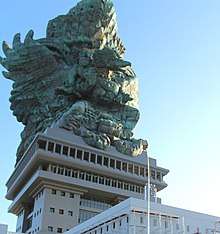
- In Bali and Java, the Garuda has become a cultural symbol. The wooden statue and mask of Garuda is a popular feature in artworks and souvenirs.
- Garuda has identified as Indonesia national football team in international games, namely "The Garuda Team".[37]
- The stylized brush stroke that resembles Garuda appears in the logo of 2011 Southeast Asian Games, held in Palembang and Jakarta, Indonesia.
- The stylized curves that took the form of Garuda Pancasila appears in the logo of Wonderful Indonesia tourism campaign.
- Garuda becomes the inspiration for national costumes worn by Puteri Indonesia at Miss Universe 2012 and Miss Universe 2016 beauty pageant.
- "Garuda Restaurant" also known as Restoran Garuda - a well known restaurant in Indonesia which prepares Minangkabau cuisine
Japan
- The Karura (迦楼羅) is a divine creature with human torso and birdlike head in Japanese Hindu-Buddhist epics.[38]
- The name is a transliteration of Garuda (Sanskrit: Garuḍa गरुड; Pāli: Garuḷa) a race of enormously gigantic birds in Hinduism, upon which the Japanese Buddhist version is based. The same creature may go by the name of konjichō (金翅鳥, lit. "gold-winged bird", Skr. suparṇa).
Mongolia
- The Garuda, known as Khangarid, is the symbol of the capital city of Mongolia, Ulan Bator.[39] According to popular Mongolian belief, Khangarid is the mountain spirit of the Bogd Khan Uul range who became a follower of Buddhist faith. Today he is considered the guardian of that mountain range and a symbol of courage and honesty.
- Khangarid (Хангарьд), a football (soccer) team in the Mongolia Premier League also named after Garuda.
- Garuda Ord (Гаруда Орд), a private construction and trading company based in Ulaanbaatar, also named after Garuda.
- State Garuda (Улсын Гарьд) is a title given to the debut runner up in wrestling tournament during Mongolian National Festival Naadam.
Myanmar
Nepal
| Wikimedia Commons has media related to Garuda in Nepal. |
Garuda is found in Nepalese traditions of Hinduism and Buddhism.
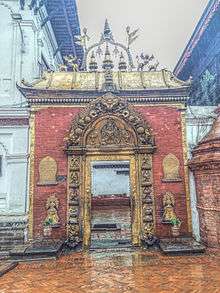
.
Philippines
- Galura surname in Kapampangan language originally comes from the Sanskrit Garuda.
- The Maranao people of southern Philippines believe in a race of creatures called garuda who dwell beneath the sea. These beings are winged, have big teeth, and huge talons that can carry six men. They look like eagles when flying in the sky but transform into humans when in their lairs.[42]
Suriname
- In Suriname, there is a radio and TV station called Radio en Televisie Garuda, which broadcasts programming from Indonesia, particularly Java, aimed at the Javanese Surinamese population.
Thailand
| Wikimedia Commons has media related to Garuda in Thailand. |
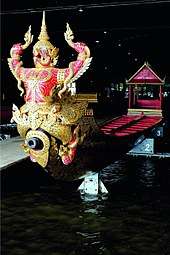
Thailand uses the Garuda (Thai: ครุฑ, khrut) as its national symbol, known as the Phra Khrut Pha, meaning "Garuda, the vehicle (of Vishnu)," also used as the symbol of royalty.[43] It adorns the banknote of their currency - the Baht - as well.[44]
- The Kingdom of Siam has had an image of Garuda in its coins at least since the Ayutthaya era.[44]
- Statues and images of Garuda adorn many Buddhist temples in Thailand. It also has become a cultural symbol of Thailand.
- The figure of Garuda is also installed as the figurehead or masthead of Thai royal barges.
United States
The Electronic Attack Squadron 134 (VAQ-134) of the United States Navy is named after and uses the Garuda Insignia.
Gallery
- Insignia
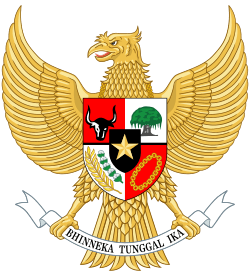 Garuda as national symbol of Indonesia
Garuda as national symbol of Indonesia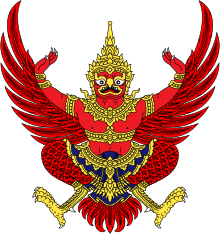 Garuda as national symbol of Thailand
Garuda as national symbol of Thailand Garuda (Khangardi) as the symbol of Ulan Bator, Mongolia
Garuda (Khangardi) as the symbol of Ulan Bator, Mongolia
- Coins
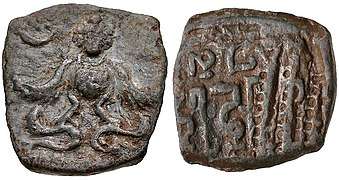 5th-century Gupta-era coin, Garuda with snakes in his claws
5th-century Gupta-era coin, Garuda with snakes in his claws 6th century coin with Garuda and Vishnu's chakra and conch on side
6th century coin with Garuda and Vishnu's chakra and conch on side A Cambodian coin during French Protection period 1853.
A Cambodian coin during French Protection period 1853.
- Temples
- Garuda iconography at a Radha Krishna Temple in Kolkata.
 8th century Garuda carrying Vishnu in Aihole, Karnataka, India
8th century Garuda carrying Vishnu in Aihole, Karnataka, India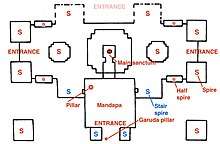 8th century Garuda pillar location at a Shiva temple, Masrur Temples, Himachal Pradesh India
8th century Garuda pillar location at a Shiva temple, Masrur Temples, Himachal Pradesh India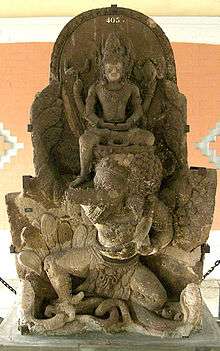

 The statues of Krut battling naga serpent, a Thai Buddhist adaptation of Garuda in Wat Phra Kaeo temple, Thailand.
The statues of Krut battling naga serpent, a Thai Buddhist adaptation of Garuda in Wat Phra Kaeo temple, Thailand.
 Head of a Garuda during the 14th century Cambodia, Honolulu Museum of Art
Head of a Garuda during the 14th century Cambodia, Honolulu Museum of Art- Garuda pillar, Nepal
- Garuda at Durbar square in Kathmandu, Nepal.
 Garuda at the funeral of King Bhumibol Adulyadej of Thailand in 2017
Garuda at the funeral of King Bhumibol Adulyadej of Thailand in 2017
- Artworks
 Garuda figure, gilt bronze, Khmer Empire Cambodia, 12th-13th century, John Young Museum, University of Hawaii at Manoa
Garuda figure, gilt bronze, Khmer Empire Cambodia, 12th-13th century, John Young Museum, University of Hawaii at Manoa Garuda returning with the vase of Amrita
Garuda returning with the vase of Amrita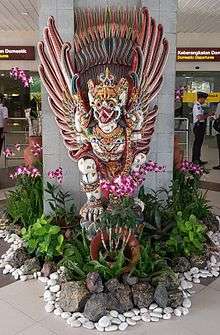
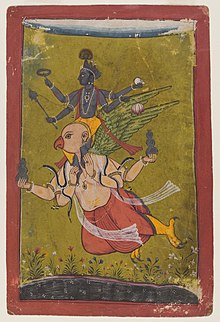 Vishnu riding Garuda
Vishnu riding Garuda Garuda carries Vishnu and Lakshmi
Garuda carries Vishnu and Lakshmi
See also
Notes
- Robert E. Buswell Jr.; Donald S. Lopez Jr. (2013). The Princeton Dictionary of Buddhism. Princeton University Press. pp. 314–315. ISBN 978-1-4008-4805-8.
- Roshen Dalal (2010). Hinduism: An Alphabetical Guide. Penguin Books. p. 145. ISBN 978-0-14-341421-6.
- Helmuth von Glasenapp (1999). Jainism: An Indian Religion of Salvation. Motilal Banarsidass. p. 532. ISBN 978-81-208-1376-2.
- Robert E. Buswell Jr.; Donald S. Lopez Jr. (2013). The Princeton Dictionary of Buddhism. Princeton University Press. pp. 249–250. ISBN 978-1-4008-4805-8.
- George M. Williams (2008). Handbook of Hindu Mythology. Oxford University Press. pp. 21, 24, 63, 138. ISBN 978-0-19-533261-2., Quote: "His vehicle was Garuda, the sun bird" (p. 21); "(...) Garuda, the great sun eagle, (...)" (p. 74)
- T. A. Gopinatha Rao (1993). Elements of Hindu iconography. Motilal Banarsidass. pp. 285–287. ISBN 978-81-208-0878-2.
- Thomas E. Donaldson (2001). The iconography of Vaiṣṇava images in Orissa. DK Printworld. pp. 253–259.
- Roshen Dalal (2010). The Religions of India: A Concise Guide to Nine Major Faiths. Penguin Books. p. 123. ISBN 978-0-14-341517-6.
- "Archived copy". Archived from the original on 27 August 2013. Retrieved 17 March 2010.CS1 maint: archived copy as title (link) CS1 maint: BOT: original-url status unknown (link)
- "Garuda's population now 500 in Bhagalpur, Bihar". Zee News. 21 June 2015. Archived from the original on 23 July 2015.
- "Stork nests spread". The Telegraph. 16 May 2020.
- Roshen Dalal (2010). Hinduism: An Alphabetical Guide. Penguin Books. pp. 144–145. ISBN 978-0-14-341421-6.
- George M. Williams (2008). Handbook of Hindu Mythology. Oxford University Press. pp. 138–139. ISBN 978-0-19-533261-2.
- Mark S. G. Dyczkowski (1988). The Canon of the Saivagama and the Kubjika: Tantras of the Western Kaula Tradition. State University of New York Press. pp. 40–41. ISBN 978-0-88706-494-4.
- Peter Heehs (2002). Indian Religions: A Historical Reader of Spiritual Expression and Experience. New York University Press. pp. 195–196. ISBN 978-0-8147-3650-0.
- Dominic Goodall (2001). Hindu Scriptures. Motilal Banarsidass. pp. 341–358. ISBN 978-81-208-1770-8.
- Gupta, The Roots of Indian Art, 1980, p.29
- Bhūmi
- George Michell (2015). Badami, Aihole, Pattadakal. Jaico Publishing. pp. 49–52. ISBN 978-81-8495-600-9.
- George M. Williams (2008). Handbook of Hindu Mythology. Oxford University Press. pp. 62–63. ISBN 978-0-19-533261-2.
- Gopal, Madan (1990). K.S. Gautam (ed.). India through the ages. Publication Division, Ministry of Information and Broadcasting, Government of India. p. 70.
- Ashok, Banker K (2012). Forest of Stories. Westland. pp. 173–175. ISBN 978-93-81626-37-5. Retrieved 6 March 2013.
- Brenda Rosen (2010). Mythical Creatures Bible. Godsfield Press. p. 158. ISBN 978-1402765360.
- Ludo Rocher (1986). The Purāṇas. Otto Harrassowitz Verlag. pp. 175–177. ISBN 978-3-447-02522-5.
- Johannes Adrianus Bernardus Buitenen (1973). The Mahabharata, Volume 3 (Book 4: The Book of the Virata; Book 5: The Book of the Effort). University of Chicago Press. pp. 167–168, 389–393. ISBN 978-0-226-84665-1.
- Moriz Winternitz (1996). A History of Indian Literature, Volume 1. Motilal Banarsidass. pp. 291–292. ISBN 978-81-208-0264-3.
- Jean Philippe Vogel (1995). Indian Serpent-lore: Or, The Nāgas in Hindu Legend and Art. Asian Educational Services. pp. 53–54. ISBN 978-81-206-1071-2.
- K. D. Bajpai (October 2004). Indian Numismatic Studies. Abhinav Publications. pp. 19–24, 84–85, 120–124. ISBN 978-81-7017-035-8.
- Hsia, C.T. C. T. Hsia on Chinese Literature. Columbia University Press, 2004 (ISBN 0231129904), 154
- Hsia, C. T. Hsia on Chinese Literature, pp. 149
- Hsia, C.T. C. T. Hsia on Chinese Literature, pp. 149 and 488, n. 30
- Chau, Ju-Kua, Friedrich Hirth, and W.W. Rockhill. Chau Ju-Kua: His Work on the Chinese and Arab Trade in the Twelfth and Thirteenth Centuries, entitled Chu-Fan-Chi. St. Petersburg: Printing Office of the Imperial Academy of Sciences, 1911, p. 149, n. 1
- Studies in South Asian Culture. Universiteit van Amsterdam. Institute of South Asian Archaeology. p. 24.
- Abhishek Saksena (4 January 2016). "Here's everything you need to know about Indian Air Force's elite Garud Commandos #Pathankotattacks". India Times.
- Khmer dictionary of Buddhist institute of Cambodia, published in 1967.
- "Bali The Garuda Wisnu statue is set to become second tallest statue in the world". Architecture & Design. Retrieved 8 March 2020.
- Garuda Team
- "Karura 迦楼羅, Karura-Ō 迦楼羅王 (Skt. = Garuda) Bird of Life, Celestial Eagle, Half Bird Half Man". Japanese Buddhist Statuary.
- Michael Kohn. Mongolia. Lonely Planet, 2005. p. 52.
- Maitrii Aung-Thwin (2011). The Return of the Galon King: History, Law, and Rebellion in Colonial Burma. NUS Press. p. 122. ISBN 9789971695095.
- Taleju Bhawani and Kumari (goddess) worship
- "A Compendium of Creatures & Mythical Beings from Philippine Folklore & Mythology". The Aswang Project.
- "Thailand Information". Royal Embassy of Thailand in Doha, Qatar.
- "Garuda: a symbol on Thai currency". emuseum.treasury.go.th.
